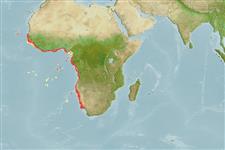Elasmobranchii (sharks and rays) >
Rajiformes (Skates and rays) >
Rajidae (Skates)
Etymology: Raja: Latin, raja, -ae = a sting ray (Raja sp.) (Ref. 45335); straeleni: Named after V. Van Straelen, director of IRSNB, Belgium (Ref. 377).
More on author: Poll.
Environment: milieu / climate zone / depth range / distribution range
Ecology
Marine; demersal; oceanodromous; depth range 80 - 800 m (Ref. 11284), usually 100 - 300 m (Ref. 26999). Tropical; 15°N - 30°S
Eastern Atlantic: Rio de Oro, Western Sahara to South Africa.
Size / Weight / Age
Maturity: Lm ? range ? - ? cm
Max length : 70.0 cm TL male/unsexed; (Ref. 26999); 67.0 cm TL (female); max. published weight: 1.4 kg (Ref. 377); max. published weight: 1.4 kg
Short description
Identification keys | Morphology | Morphometrics
A black-spotted skate with a blunt, angular snout, a long, stout tail, and a broad angular disc; strong thorns on upper surface of disc and tail at all stages, sometimes on underside in large individuals (Ref. 5578). Brown to grey dorsally, with small to large black spots, whorls and blotches; many with gold and black, traversely oblong eyespot on each pectoral base; white ventrally with no dark pores (Ref. 5578). Juveniles have no dark spots above (Ref. 2708).
Found in shallow enclosed bays and on the slope (Ref. 5578). Feeds on invertebrates, bony fishes and fish offal. Oviparous (Ref. 50449). Eggs have horn-like projections on the shell (Ref. 205). Caught by shore and ski-boat anglers and by hake trawlers. Pectoral fins sold as 'skate wings' (Ref. 5578). Undergoes regular migration, towards the coast during the warm season and towards deep waters in winter (Ref. 5377).
Life cycle and mating behavior
Maturities | Reproduction | Spawnings | Egg(s) | Fecundities | Larvae
Oviparous, paired eggs are laid. Embryos feed solely on yolk (Ref. 50449).
McEachran, J.D. and K.A. Dunn, 1998. Phylogenetic analysis of skates, a morphologically conservative clade of elasmobranchs (Chondrichthyes: Rajidae). Copeia 1998(2):271-290. (Ref. 27314)
IUCN Red List Status (Ref. 130435)
Threat to humans
Harmless
Human uses
Fisheries: commercial; gamefish: yes
Tools
Special reports
Download XML
Internet sources
Estimates based on models
Preferred temperature (Ref.
123201): 10.2 - 15.7, mean 12.3 °C (based on 76 cells).
Phylogenetic diversity index (Ref.
82804): PD
50 = 0.5000 [Uniqueness, from 0.5 = low to 2.0 = high].
Bayesian length-weight: a=0.00363 (0.00228 - 0.00578), b=3.21 (3.08 - 3.34), in cm total length, based on LWR estimates for this species & Genus-body shape (Ref.
93245).
Trophic level (Ref.
69278): 4.0 ±0.62 se; based on food items.
Resilience (Ref.
120179): Low, minimum population doubling time 4.5 - 14 years (Fec assumed to be <100).
Fishing Vulnerability (Ref.
59153): Moderate to high vulnerability (48 of 100).
